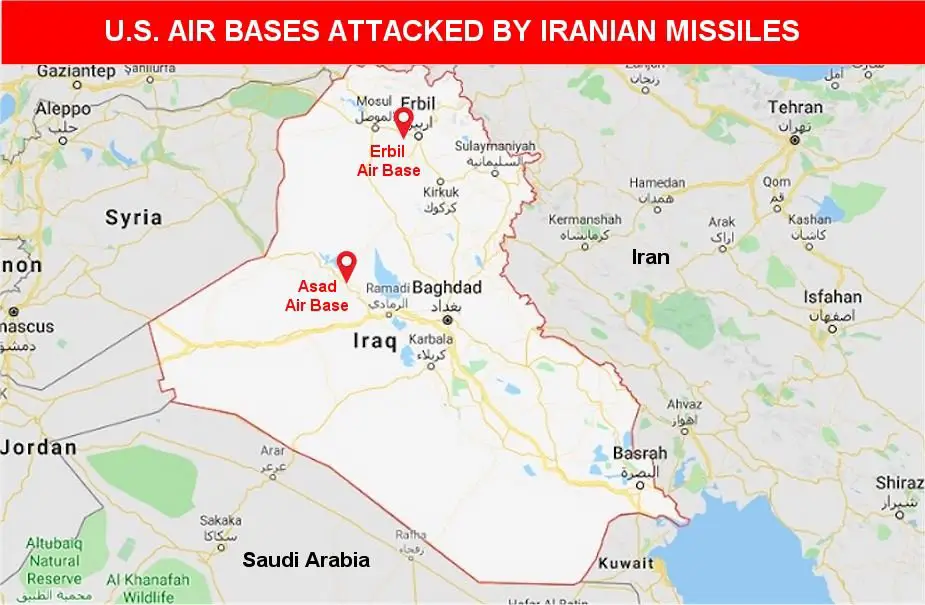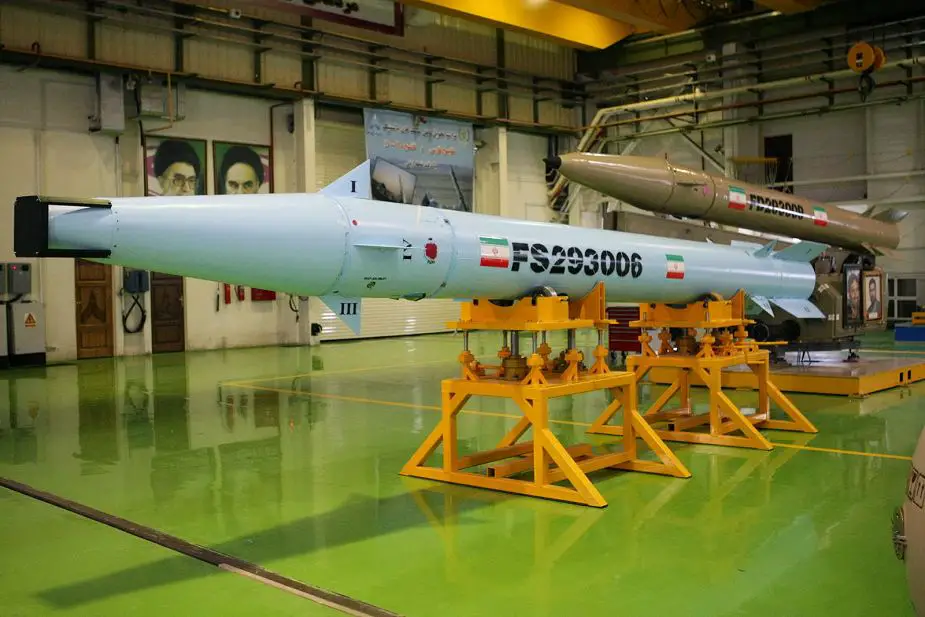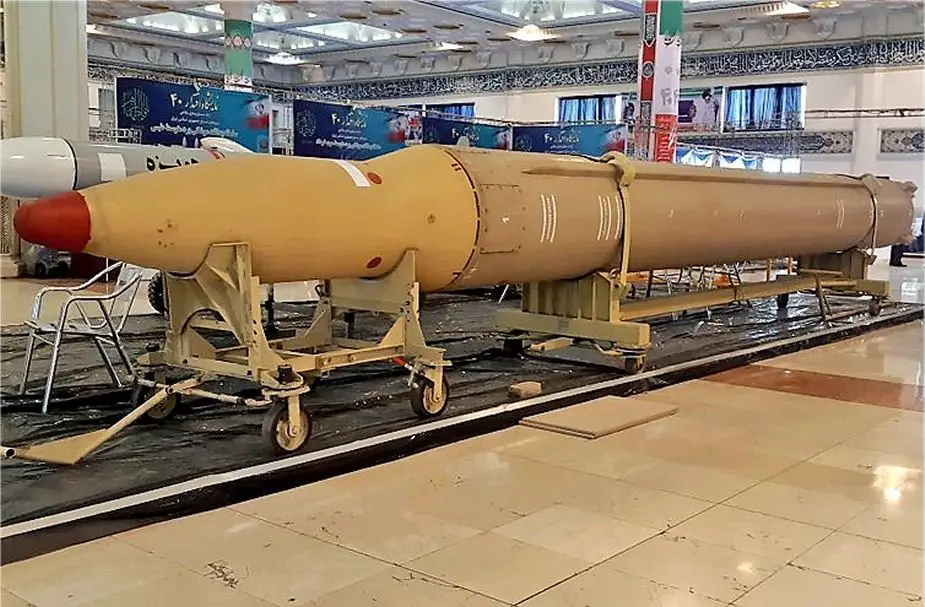As expected… At 1:30 AM in Iraq on January 8, a series of missile launch reports appeared on radar screens as Iran launched a promised retaliatory strike against U.S. bases in Iraq codenamed “Operation Martyr Soleimani”. The attack was precisely ordered by Tehran at the same hour Iranian general Qassem Soleimani was killed by a U.S. drone strike on January 3, 2020, and following the general’s burial on January 7.

Iranian missiles hit two U.S. bases in Iraq at 1:30 AM in Iraq on January 8, 2020 (Map source: Army Recognition)
Iran claims it launched ten Fateh-110 as well as Quiam short-range ballistic missiles—the Pentagon reported “over a dozen”—at U.S. forces in Iraq in at least two locations: Ain-al-Asad airbase and Erbil, in central and northern Iraq respectively. One struck a base in Erbil in Iraq’s semiautonomous Kurdish region. Longer-range, liquid-fuel Qiam ballistic missiles may have been used in the attack on strike Ain-al-Asad as well. Four missiles failed to hit their targets. None of both bases hit were protected by Patriot or other adequate air defense systems, which the Iranians knew as they couldn't afford a political failure in their operation.
The Qiam is a short-range ballistic missile designed and built by Iran. It was developed from the Iranian Shahab-2, a licensed copy of the North Korean Hwasong-6, all of which are versions of the Soviet Scud-C missile. The Qiam 1 entered service in 2010, with a range of 750 km (470 mi) and 500 m (1,600 ft) (CEP) accuracy.
The Fateh A-110 is a short-range, road-mobile, solid-propellant ballistic missile based on the Russian made missile R-65 FROG, but other sources said it is a copy of the Chinese DF-11. It is most likely a modified version of the unguided Zelzal-2 ground-to-ground missile, with the addition of control and guidance systems. The Fateh-110 is a single-stage, solid-propellant, surface-to-surface missile. Produced in Iran, it has a range of at least 200 km. Some sources on the Internet indicate that the missile is 8.86 m long, 0.61 m in diameter, and weighs 3,450 kg. It uses a single-stage solid-propellant engine and has a range of 210 km (130 miles), although it is possible that Iran will add extra boosters in order to increase its range to 400 km (249 miles).
Ain al-Asad airbase, one of the targeted bases by Iran, is a large hub for U.S. forces in Iraq. The base, a sprawling complex about 110 miles northwest of Baghdad located in the western Anbar desert, houses about 1,500 members of the U.S. military and the U.S.-led coalition fighting ISIS. In addition to the 1,500 U.S. and coalition forces, about 70 Norwegian troops were at Ain al-Asad at the time of the attack.
The Pentagon is assessing the damages before taking attitude, Iran claiming 80 killed U.S. servicemen in a fierce communication/media battle between both enemies. “All is well, so far so good” as tweeted by President Trump might be disputed. The Federal Aviation Administration is barring U.S. pilots and carriers from flying in areas of Iraqi, Iranian and some Persian Gulf airspace. Such restrictions are often precautionary in nature to prevent civilian aircraft from being confused for ones engaged in armed conflict. Other airlines are following the move. And oil prices are already sharply increasing. Iranian cyberattacks are naturally expected.
Chief of Staff of the Iranian Armed Forces warned the US that any new evil act will draw Iran’s “stronger, more crushing, and broader” response, hours after the IRGC stormed two US military bases in Iraq in retaliation for the assassination of Lt. General Qassem Soleimani. He said the attacks on the American forces in Iraq revealed only a tiny part of the capabilities of the Iranian Armed Forces and was carried out in response to the US terrorist move to assassinate General Soleimani. “From now on, any new evil act by the US will face a stronger and more crushing response with a broader range,” the senior Iranian general added.
As a useful reference for the harsh relation between the U.S. and Iran, Army Recognition uses hereunder a document issued in 2017 with Iranian FARS News Agency and SIPRI data among others. This adds to the fight waged by the US to counter the Iranian growing influence in the region, a policy of expansion that deeply irritates the U.S.’ allies.

Iranian-made Fateh-110D short-range ballistic missile (Source Iranian Press Agency)
Iran goes on with its missile programme
The matter often comes in the media: Iran’s ballistic missile programme has long been a source of tension. For the Islamic Republic, these missiles are an important element of military doctrine, a means of deterrence, and a tool of statecraft.
The link between the missile programme and the country’s nuclear programme is perceived as a primary threat by the international community, which addresses the matter as such and consequently imposes supply-side restrictions.
The international community failed in attempting to include ballistic missiles in the long-negotiated agreement over Iran’s nuclear programme, since Iran strongly refused the connection. The Joint Comprehensive Plan of Action (JCPOA) took a compromise approach, relegating the matter to a new United Nations Security Council resolution (Resolution 2231) and imposing an eight-year conditional ban.
Nuclear agreement and ballistic missile programme: a sensitive connexion
The implementation of the nuclear agreement is closely linked to Iran’s ballistic missile programme: the international community wants to be reassured that Iran does not develop a nuclear warhead to mount on a missile. Therefore, controlling Iran’s access to sensitive goods is important. However, the limits to what export controls alone can achieve have become obvious. So, other approaches must be envisaged.
Iran, like any other country, acts according to its circumstances, and the manufacture and development of its missiles are not related to foreigners, Velayati told reporters after a meeting with European Parliament's Foreign Affairs Committee Chairman David McAllister in Tehran on 14 February.
Born in 1945, Ali Akbar Velayati is an Iranian physician and conservative politician. He is a distinguished professor at Shahid Beheshti University of Medical Sciences, senior adviser to the Supreme Leader in international affairs and head of the board of founders and the board of trustees of the Islamic Azad University. Needless to say how influential he is when defense matters are evoked.
Emphasizing that each country chooses its own defense system in proportion to its needs, he said missiles are "defensive means" in Iran’s doctrine. “To defend our country, we embark on developing missiles in line with our national interests, and this is no business of foreigners and we do not allow others to interfere (in this issue),” he said.
Velayati added that during his meetings with the EU official, they discussed Iran’s policies in the Middle East and North Africa. He said that the Islamic Republic sought cooperation with all the regional countries ”to help establish stability, security and peace”. Tehran is opposed to any foreign meddling in the region, he added.
Lieutenant Commander of the Islamic Revolution Guards Corps (IRGC) Brigadier General Hossein Salami reiterated Iran's firm opposition to talks with the foreign states on its defense and missile power: "Missile is no issue for our negotiations with any power. The nuclear deal is not related to the missile power at all; missiles are rather a part of our defense power and we will never hold talks about it," General Salami told reporters in Tehran. “The Europeans should know that the nuclear deal is not related to the development of missile power, and our determination to develop our defense power is more independent than any other power," he added.

Quiam short-range ballistic missile (Picture source Twitter Tal Inbar)
Missile programme: the early years
As recalled by the EU Non-Proliferation Consortium, Iran began developing ballistic missile capabilities during the 1980–88 war with Iraq, when the country proved unable to retaliate to Iraq’s superiority gained with Western support. To compensate for its inferiority, Iran turned to Libya. In 1984, following clandestine negotiations with Colonel Muammar Gaddafi, Iran received its first delivery of 20 Scud-B missiles that were deployed against Baghdad and other major Iraqi cities. Iran obtained additional Scud-B missiles from Syria and North Korea, and Scud-C missiles from North Korea (renamed Shahab-1 and Shahab-2, respectively). In addition to deterring Iraq, Iran was now able to hold its Arab neighbours in the Gulf at risk and complicate US intentions in the region.
Iran needed to at least double the range of Shahab-2, which at the time was limited to 500 km. Unable to achieve this goal by its own means, Iran yet again turned to North Korea. Tested between 1998 and 2003, the Shahab-3 missile (based on the North Korean Nodong) was extensively modified to improve its range and performance. It became designated as Ghadr-1. This new missile is believed to have a range of 1,600 km with a payload of 700–750 kilograms.
In the late 1990s Iran is began developing the solid-propellant short-range Fateh-110, which it first successfully tested in 2001. The first modified variant, Fateh-110A, has a range of 200–225 km. Four subsequent variants of the missile were developed over a decade, which Iran claimed to be increasingly accurate.
In November 2008, Iran tested its new, indigenously designed and produced medium-range missile known as the Sajjil. Its range is claimed to reach 2000 km. However, despite a series of tests of the Sajjil’s successor, the Sajjil-2, no further tests have been reported since 2011 and Iran has not yet declared the missile operational.
In 2010, Iran tested an indigenous liquid-propellant missile, the Qiam, which had a reported range of 700 km. It supposedly could overcome the ballistic missile defenses of Iran’s regional rivals.
In August 2015 Iran exhibited the Fateh-313, which appears to be a modified version of Fateh-110. Although Iran claims a range of 500 km, which is likely overstated.
It is commonly estimated that Iran has an inventory of approximately 200–300 Shahab-1 and Shahab-2 missiles (the figure corresponding to the number of missiles provided by North Korea). Iran has not demonstrated an ability to produce the Shahab engines itself. Estimates regarding Shahab-3/Ghadr are significantly more varied, fluctuating between 50 and 100 missiles, while other figures reach as high as 300 missiles. The lower estimate is based on the number of missiles and engines probably supplied by North Korea, and the higher one on Israeli sources that assume indigenous production by Iran. Given the difficulties involved in domestic production, this latter estimate is likely to be somewhat inflated. Iran’s holdings of Fateh-110 are difficult to approximate because they are produced domestically. Neither the Fateh-313 nor the Sajjil-2 appears to have been deployed yet.
Iran’s ballistic missiles: able to deliver a nuclear charge?
Once again, as commented by Paulina Izewicz, from the EU Non-Proliferation Forum, Iran’s capability to field an intercontinental ballistic missile (ICBM), which is traditionally defined as having a range of 5,500 km or more, has long been a source of concern. An ICBM could serve as a delivery vehicle for a nuclear warhead capable of directly threatening the USA and Western Europe. Although Iran has denied interest in developing an ICBM capability, its ambitious space programme has received significant scrutiny because of the technological overlap between ICBMs and space launch vehicles (SLVs).
In 2009 Iran used the Safir SLV to launch its first satellite, the Omid, into orbit. Although the rocket is designed to carry only a light payload into low-earth orbit, the US State Department expressed its concern with the launch, stating that ‘Iran’s development of a space launch vehicle (SLV) capable of putting a satellite into orbit establishes the technical basis from which Iran could develop long-range ballistic missile systems’.
Indeed, the Simorgh SLV is deemed to be an ‘ICBM-class booster’ by the US intelligence community, albeit with the qualification that there is ‘no evidence to suggest Iran has developed a re-entry vehicle or warhead’ for it, both of which would be crucial components. The Simorgh was reportedly launched in April 2016, but there appears to be no consensus on whether the launch was a success. In any case, it would be exceedingly difficult for Iran to simply transform it into an operational ICBM. Instead, as experts suggest, the knowledge gleaned in the development process could rather serve as the basis for developing a completely new missile.
Beginning in 1999, the US intelligence community estimated that Iran could flight-test an ICBM by 2015. This did not happen. In a congressional hearing in March 2015, the Commander of the US Northern Command and North American Aerospace Defense Command, Admiral William Gortney, moved the goalposts saying that Iran was unlikely to deploy an ICBM until ‘later this decade at the earliest
Iran’s ballistic missile programme plays an important role in national discourse and as a means of bolstering the credibility and legitimacy of the regime. Much like the nuclear programme, it is a source of pride in Iran’s technological capabilities, which are meant to insulate Iran from foreign dominance. It is also a powerful expression of Iran’s military might, around which the nation can rally. Attempts at de-emphasising the role of Iranian missiles are not met favourably. A tweet on 23 March 2016 from the Twitter account of former president Ali Akbar Hashemi Rafsanjani that proclaimed ‘the world of tomorrow is a world of discourse, not missiles’ drew sharp domestic criticism. Iran’s Supreme Leader, Ayatollah Ali Khamenei, went as far as to call such comments ‘treasonous’.
The EU, a more peaceful and efficient negotiator than the Trump administration
The nuclear agreement eliminated a major source of tension between Iran and the West: if faithfully implemented, it verifiably constrains Iran’s nuclear programme in its most sensitive aspects for well over a decade. However, it is clear that the Trump Administration is not showing the same patience employed by the Obama Administration in its relationship with Iran.
Fortunately, Iran’s relations with the EU are much less complex. Furthermore, verifiable constraints on the nuclear programme eliminated the most significant source of tension. Unlike the USA, the EU maintained its ties to Iran after the Islamic Revolution and trade flourished. It was only during the controversial presidency of Mahmoud Ahmadinejad that the nuclear crisis erupted, and relations took a turn for the worse.
A multilateral dialogue must take place on Iran’s ballistic missile programme. But let’s keep in sight what we reported earlier in this overview: Iran, like any other country, acts according to its circumstances, and the manufacture and development of its missiles are not related to foreigners, Velayati told reporters after a meeting with European Parliament's Foreign Affairs Committee Chairman David McAllister in Tehran on 14 February 2018. Nevertheless, although ambitious and mired in significant challenges, such a multilateral dialogue should not be dismissed out of hand.
While it is true that Iran refused to include its ballistic missile programme as part of the JCPOA negotiations, there are reasons to believe it might be willing to engage on some aspects of the programme under the right circumstances. For instance, Iranian officials have repeatedly stated that the current range of Iranian missiles is sufficient for its purposes. This range, of course, allows it to hold at risk a wide array of targets but it could nonetheless serve as a starting point for further discussions; it would also constitute an important confidence-building measure. Initial exploration of such an idea could take place, allowing all relevant actors to informally ‘take the temperature’, as pertinently said by Paulina Izewicz, and possibly set parameters for further discussion. Here, too, the EU could ultimately play an important role as a facilitator thanks to its better relationship with Iran the US one.














